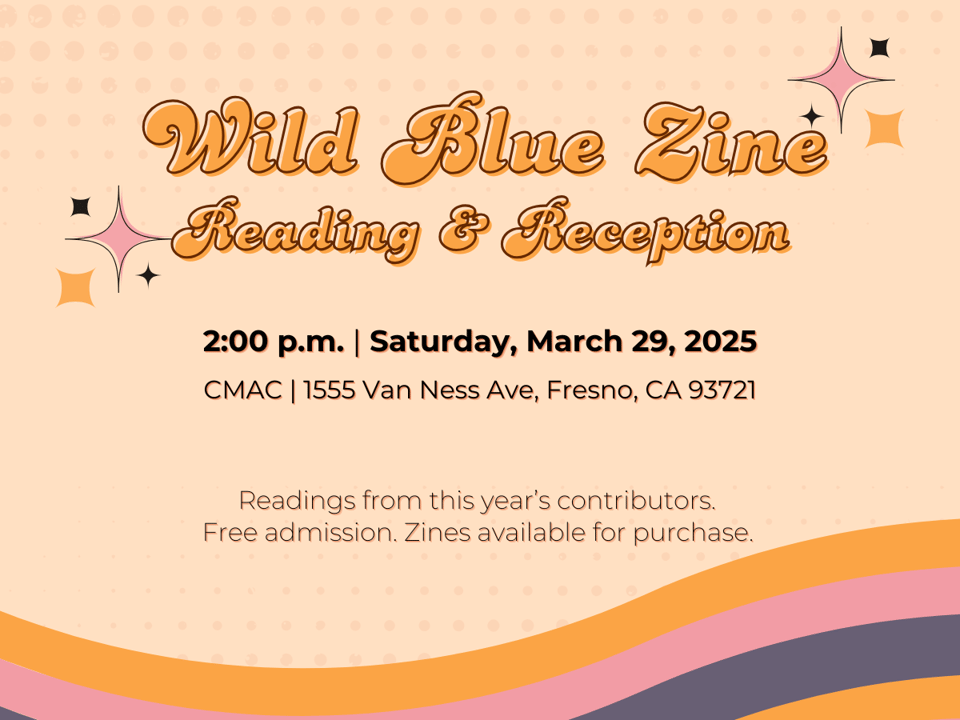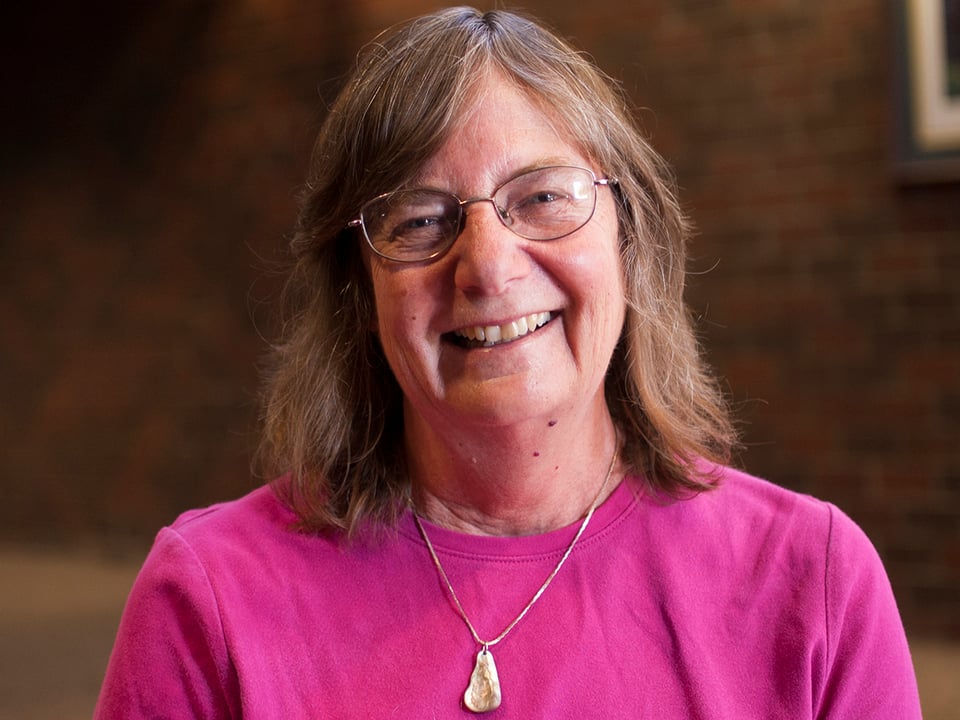Scrub Jay Flyer - February 2025

Hello, dear readers. There’s lots happening at Scrub Jay Press at the moment.
Work on our new zine is nearly complete and a launch event is now scheduled. Plans are starting to cook for our fourth generation Fresno writers anthology, projected for fall 2026 publication. And we’re steadily checking off to-do items on our list of administrative tasks, which of course isn’t as fun to talk about as new books but can sometimes feel just as rewarding.
Looking forward to a smooth flight into the spring.
– Jefferson Beavers

Save the date for Wild Blue Zine launch
Mark your calendar for 2 PM on Saturday, March 29 for the launch of Wild Blue Zine volume 2, the first new publication of the Scrub Jay Press 2.0 era.
The zine launch will include a reading and reception, and it will take place inside the television studio at the Community Media Access Collaborative (CMAC), 1555 Van Ness Ave. in downtown Fresno. The event will be hosted by Wild Blue Zine editors Marisa Mata and Taylor Seals.
We are pleased to share the lineup of contributors!
Paul Aloojian
Stephen Barile
Audra Burwell
David R. Carrasco-Gomez
Soreath Hok
Anjali Kapoor-Davis
Shannon C. Matalone
Sharon K. McClain
John Moses
James O’Bannon
meche olvera
Senia Rodriguez
Lisa MC Weston
You can pre-order your copy for $10. Under the Add Note section, write-in “pickup” if you’re coming to the launch. If we miss you, mailings will go out the following week.

Five Questions with Chris Henson, co-founder of Scrub Jay Press
Our publisher Jefferson Beavers recently sat down with Scrub Jay Press co-founder and publisher emerita Chris Henson, to ask her about the origins of the press. Chris ran the press for 14 years alongside fellow co-founder and husband Eugene Zumwalt, who passed away in 2023 at age 99.
What was the inspiration for the name Scrub Jay Press?
Scrub jays are, of course, all around in this region, and they’re definitely up where we live in the foothills. There’s lots and lots of scrub jays. Eugene was – and me too, but him especially – a bird watcher, and he was very interested in all birds.
At one point we were visiting Point Reyes in Marin County, and there was a place – formerly part of the Point Reyes Bird Observatory – that studies birds of the region. We found out you could go there and visit, and they would give you a little bird tour. It wasn't a very big place. But we went, and this very nice man there gave us the tour. He started by showing us where they catch birds in mist nets. It's a very fine net that the bird flies into and then gets tangled in. But it doesn't harm the bird because it's such fine netting. And so, they bring the birds in, they weigh them and measure them and band them, to keep records, and they've been operating like this for 20 years or more.
So, we went out to see the mist nets. We’re walking around and the guide is showing us the mist nets – there are quite a few of them at bird-flying height – and Eugene said to him, you must catch a lot of scrub jays. And the guide said, in his 20 years there, they had never caught a scrub jay. They somehow know how to evade the mist nets, and perhaps even teach each other to evade the mist nets. They’re not sure, but they’ve never caught one.
We loved that story! And so, before the operation of the press, Scrub Jay became the name of one of the boats we had, and then when we restarted what had been The Zumwalt Press, it became the name for the press. We really liked the wiliness of the scrub jay. It cannot be caught.
Tell me about the many roles that you and Eugene each had in running the press together, from 1996 to 2010.
Scrub Jay Press was a reincarnation of The Zumwalt Press, which ran from 1973 to 1982. Eugene and Roger Chittick co-operated it. And so, when Eugene was near retirement from Fresno State, we talked about restarting the press and then decided to do it.
Eugene did pretty much all the actual printing work – the first two books, on a 19th Century Chandler-Price platen press – and that was all hand-setting type, breaking down the type, and actually running the press. He did the same with the later books on the offset press. I occasionally did a little bit of feeding the paper, but mostly he did all the actual press work.
We hand-assembled all the pages in the shop, keeping all the pages in order, and then it was an endless process of walking around and around and around. I did a lot of that, the assembly. Then Eugene did most of the binding, by hand. Eugene also did the book layout and working with the authors. We always had an author contract, and he and I would talk each of those through together. And he did quite a bit of the initial editing, while I did a lot of the proofreading as the stuff came off the press.
The first book was David R.C. Good’s book of poems, “We Breathe the Sky,” and that was a mutual decision. We both knew David, who taught at Reedley College. For David’s book, and for Don Parkey’s book as well, we hand-cut the covers. I chose the paper and chose the cover stock, and then Eugene did most of the cutting. But then we had to actually crease the covers and hand-paint on the glue and attach it for those two books. Later, we had some books bound elsewhere, but we also bought a small machine that could do some binding. A lot of it was very tedious work.
And then once the books were printed, Eugene was kind of on to the next thing. So, I did press releases, contacted people about selling books, handled any orders that came in, and did all the mailing. We always felt there could have been more publicity and marketing for our books, but we ran out time to do more before the next book.
Which book or author was your favorite to work with, or the most unusual to work with?
Each of the seven authors we worked with was interesting, in different ways. I think David Good was definitely a favorite for both of us. As I said, we both knew him well. David was such a joy, such a gentle soul. We had quite a number of meetings where we talked about the order of the poems, because the order didn't really come easily to him at first.
The Jim Dumas book was interesting in multiple ways. He was kind of a big personality. “Longburst and the Flying Tigers” was a book he had written quite a while before and had never really found an outlet for, and this of course was before self-publishing when you could print stuff easily online. So, editing with him was sometimes a challenge, but Dumas connected with Eugene because they both had World War II pilot experience, so they had that in common. He had also been the mayor of Chowchilla during the whole bus kidnapping thing, so we got to hear a little bit about that from him too.
Then, in order to promote and sell the Dumas book, we went to three or four air shows. I think it was in Madera, I’m not sure if they have them there anymore. With the air show audience, it definitely worked to sell the books! But I didn’t care for the air shows, it was Eugene who loved them. The pilot in him, he thought it was great.
And then the book that was most interesting to me, I think, was the one we did with Dean Dablow, about the Louisiana pictures. Dean was a very good friend of Eugene’s son, Gary. We did most of the talking and editing long-distance. I just found all the pictures fascinating, the pictures that were taken during the Great Depression, and then new pictures made of the same places. Eugene had to learn a lot of new things to make that book. He bought an old offset press, the guy he bought it from came out and taught him how to use it, and he built a darkroom right in the shop to print all the photographs.
What will become of the physical printing presses and all the lead type, paper cutters, and equipment now, as Scrub Jay Press 2.0 goes digital?
The Chandler-Price that we did the two books of poetry on, it has a new home. It’s now in Mariposa. There's a young guy who bought it and came out with his father and a rented trailer. It took them a long time because it’s very heavy, even though it was the smallest of the presses we have. Much of it is cast iron, and it took them about five hours to get it carefully from where it was in the shop, onto the trailer.
Once he got it moved into its new space, he sent me pictures. They did break one gear, but he has managed to get that replaced, and he sent me a picture of the press operating again. I also gave him a bunch of cuts of various images, and one was of a bear. And so, there's a video he sent me of his hand going in with a piece of paper, then pulling out the bear and showing it to the camera. At some point, I'm going to go see the press back in operation.
All of the type is still in the shop, there are at least three or four cabinets. You know, fonts like Bodoni, Garamond, and there's others that that we never even used. There’s also a giant paper cutter, and I haven't found a home for that. There’s a big proof press, made by a company called Nolan. It’s a flat kind of metal thing and it has a roller, and you just print one thing at a time with the roller. It was used to make proofs, evidently, but it could also be used for printing broadsides or posters, that kind of thing.
There are three other presses: the offset press, and then two other presses from Eugene’s earlier days that I've never seen in operation. I’m not sure of the makers of the three presses, but I can look. I have not yet found homes for any of those. I still have lots of this kind of equipment. Maybe someone reading this will reach out or share it. You never know, when people read this, they could be like, oh yes, that could be exactly what I’m looking for.
What do you hope for the next incarnation of Scrub Jay Press under its new publisher and editors?
Well, I’m really delighted that Scrub Jay Press is continuing. I think about Eugene’s vision. He spent so many years in Fresno, and he realized how rich a community of poets and writers it has been for so many years. He wanted very much to be part of that community, and a continuation of that community, and so I would hope that the current incarnation would be the same, particularly for poetry, because that was Eugene’s biggest interest.